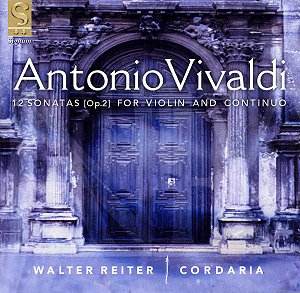|
|
Search MusicWeb Here |
|
 |
||
|
Founder:
Len Mullenger (1942-2025) Editor
in Chief:John Quinn
|
|
|
Search MusicWeb Here |
|
 |
||
|
Founder:
Len Mullenger (1942-2025) Editor
in Chief:John Quinn
|
 |
Antonio VIVALDI
(1678-1741) 12 Sonatas for Violin and Continuo Opus 2 Sonata no. 1 in G minor [9.27] Sonata no. 2 in A major [6.03] Sonata no. 3 in D minor [11.36] Sonata no. 4 in F major [11.43] Sonata no. 5 in B minor [7.08] Sonata no. 6 in C major [9.35] Sonata no. 7 in C minor [6.28] Sonata no. 8 in G major [6.49] Sonata no. 9 in E minor [10.43] Sonata no. 10 in F minor [8.09] Sonata no. 11 in D major [8.21] Sonata no. 12 in A minor [10.11] Rec: May and August, 1998. |
| CD available for post-free online mail-order or you may download individual tracks. For some labels you can download the entire CD with a single click and make HUGE savings. The price you see is the price you pay! The full booklet notes are available on-line. | |
|
NOTE • Click on the button and you can buy the disc or read the booklet details • You can also access each track which you may then sample or down load. • Further Information. |
|
|
These sonatas are clearly influenced by Corelli's opus 5 violini sonatas, which established norms in form and style at the time. While Vivaldi used the 'da camera' form, where most of the three or four movements of the sonata were dance movements, he takes a bit more liberty in the abstract movements. These sonatas all range from three to five movements, and, on this recording, their timings range from just over 6 minutes to more than 11 minutes. Individual movements range from the presto of the second sonata (27 seconds!) to the long prelude of the third sonata (just shy of 7 minutes). In most of the sonatas, the prelude is the longest movement; this gives a feeling that some of them are unbalanced - take the sixth sonata, for example, the prelude is over 6 minutes long, and the two other movements total less than 3½ minutes. In any case, these works come at a time when Vivaldi was not yet Vivaldi; or, at least, when he had not developed his signature style. One can hear the beginnings of this style in these works, and, while some have called these sonatas 'immature', they are far from that. While not being in the same vein as the Four Seasons and other great Vivaldian works, they are certainly masterpieces. Walter Reiter's performance of these works is excellent. His playing is tasteful, his ornamentation subtle and attractive, and he obtains a beautiful tone from his violin. This recording exudes a great deal of joy and happiness; under Reiter's bow, this is clearly music to be enjoyed. His mastery of the rhythms of the dance music, his virtuosity when called for, and his restraint when needed all add up to provide an immensely satisfying performance. An example is the long prelude in the third sonata, where Reiter plays with such fluidity and flexibility, giving the sinuous melodies just the right highlights and phrasing. These are works where the violin is presenting a discourse, and Reiter's approach seems flawless. There is also a perfect balance among the other various instruments (harpsichord and cello; theorbo or baroque guitar in three of the sonatas), and the recording is impeccable. The sound comes across with such clarity and beauty that one is enraptured, especially when listening on headphones. An excellent recording of some of Vivaldi's earliest works. Far from being immature works, these sonatas take on a new dimension in this performance. Highly recommended. Kirk McElhearn
|
|
ADDITIONAL INFORMATION •
You can sample only 30 seconds (or 15% if that is longer) of a given track. Select from the View tracks list. Each sample will normally start from the beginning but you can drag the slider to any position before pressing play. • PLEASE NOTE: If you are behind a firewall and the sound is prematurely terminated you may need to register Ludwig as a trusted source with your firewall software.
•You will need Quicktime to hear sound samples. Get a free Quicktime download here • If you cannot see the "Sample All Tracks" button you need to download Flash from here.
|
|
|
Return to Index |